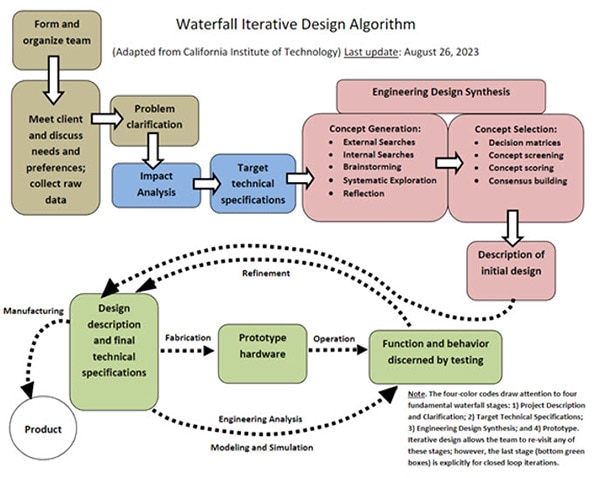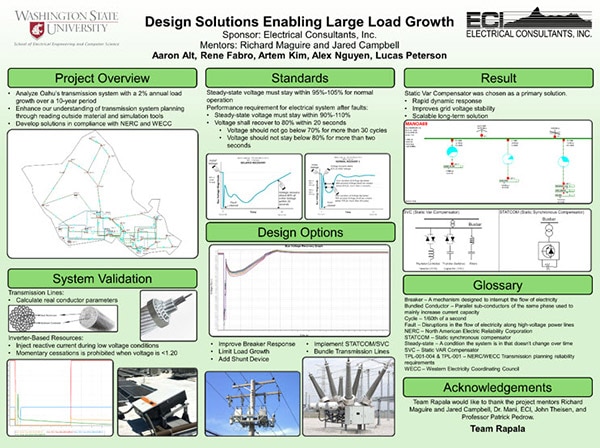Transmission Power World Simulator - A Capstone Project
2024-09-18 | By Alex Nguyen
My capstone project focused on Oahu’s transmission system. My team and I evaluated the impacts on the system with a projected 2% annual load growth over ten years and designed solutions necessary to maintain adequate transmission system performance. The blog will cover the two semesters of my senior design project. It will introduce the project, provide expectations for the class, and discuss the final design for each semester. I chose this project due to my deep-rooted passion for the power industry. My aspiration to work in this field stems from a desire to help people and contribute to a better future.
Semester 1: Alpha Prototype
Project Introduction:
To complete this project, we primarily used PowerWorld Simulator, which is highly relevant given the critical importance of electricity in modern life. The goal for the first semester was to complete PowerWorld training videos and develop a functional one-line steady-state diagram of Oahu’s transmission grid.
At Washington State University, our course was led by Professor Patrick Pedrow. Expectations may vary across different universities and professors. Throughout the semester, we engaged with our project by demonstrating all the steps of the iterative engineering design sequence, as shown in Figure 1. This semester was hands-on, requiring us to understand both the design process and our project.
 Figure 1 Waterfall Iterative Design Algorithm
Figure 1 Waterfall Iterative Design Algorithm
Throughout the semester, we were required to produce several deliverables for the class, including writing assignments, monthly reports to stakeholders, and a chat stream of technical discussions among team members. These tasks made sure that we remained focused on the technical content of the project and created continuous communication within the team. This semester was a lot more writing assignments focused, which meant there was almost one due every month. At the end of the semester, the groups had to do a presentation in front of the professor and mentor on the final alpha prototype.
Teams were formed by the professor based on a project ranking submitted by students. In my team, people volunteered for their roles. I served as the communication liaison, which meant that I was the primary contact when other people contacted the team. Other roles include a note taker for each meeting and a sprint historian who captured photographs throughout the sprint.
Alpha Prototype:
Description of Alpha Prototype:
The completed alpha prototype was a bus-level one-line steady-state model of Oahu’s transmission grid with a 2% annual load growth for one year, five years, and ten years. Steady state refers to a normal operation or a stable state following a fault event. The model was able to withstand P0, P1, and P2 level contingencies without a violation occurring. Contingency is an unexpected failure of a component. We followed Western Electricity Coordinating Council (WECC) and North American Electric Reliability Corporation (NERC) standards. WECC is responsible for creating and enforcing rules for the Western Interconnection. Although Hawaii is not part of the WECC, we adhered to these rules due to familiarity with our mentor, and they are likely to be ones we will deal with if we go into transmission planning. NERC is a regulatory authority that ensures the reliability and security of the electric grid across North America. They develop and enforce reliability standards, assess seasonal and long-term reliability, and monitor the power system. The design was scaled using the formula for each case. The length of the transmission line was calculated and inputted into PowerWorld, considering a 20% increase since lines don’t go completely straight from one bus to another. The design solution was that a generator at Kahe 138 needed to be turned on with lines from Waipahu–Pearl City 69 kV, Pearl City–Flower 69 kV, Honolulu–Lychee 69 kV, Surf–Coconut 69 kV, Coconut–Palm 69 kV, Haleiwa–Wahiawa 69 kV, Palm–Volcano 69 kV, Aloha–Aiea 69kV, Honolulu–Mahalo 69kV, and Flower–Honolulu 69 kV being bundled. Bundling is when parallel conductors of the same phase are made common throughout the line using spacers. This increases the current capacity.
Training:
The project began with understanding PowerWorld Simulator through mentor-recommended videos:
- Training: Simulator Interface
- Training: Simulator Case Editor
- Training: Editing and Analyzing an Existing Case
- Training: Model Explorer and Case Information Displays
- Training: Power Flow Analysis and Voltage Control
- Training: Contingency Analysis
Design Process:
Afterward, we were able to go into the waterfall iterative design algorithm to create our alpha prototype. The first step of this procedure is impact analysis where we must identify potential positive and negative impacts coupled to our design. Risk management was the approach we chose to use as it closely reflected our iterative design procedure. To identify risk, we turn toward contingency tables. The software allows us to run the contingencies, which is how we assess the risk. We implement changes to account for the violations. The team comes up with their solutions and evaluates which implementation works best.
The process of concept generation is to create a bunch of solutions that meet the specifications of the project. To generate even more, it was divided into subsystems, which were bus topology, transmission lines, and power generation. For example, depending on the layout of the bus can affect the reliability and the performance of it. The solutions for bus topology were single bus single breaker, ring bus, and breaker and a half.
For concept selection, we decided to use a concept scoring matrix instead of concept screening. The concept scoring matrix gave a more nuanced evaluation of the complex bus system options since it can consider criteria such as bus fault protection and overcurrent. The detailed analysis allowed us to select the most effective design solution: breaker-and-a-half, bundling, and adding a shunt capacitor.
Semester 2: Beta Prototype
Project Refinement:
After receiving feedback, adjustments had to be made to reflect real-life systems. These changes were to have the transmission system more accurately reflect real-life systems, which include changing the conductors’ impedances to reflect realistic values and the load, including MVAR.
Expectations for the Class:
This semester was more hands-off. There were only three writing assignments. The chat stream continued, and the monthly reports continued. The only times needed to show up in class were through the monthly design review meetings. Near the end of the semester, the teams participated in a poster session. This is what my team’s poster looked like, as shown in Figure 2.
 Figure 2 Capstone Poster (There was a misunderstanding on what our final result was, so it should be saying STATCOM instead of SVC)
Figure 2 Capstone Poster (There was a misunderstanding on what our final result was, so it should be saying STATCOM instead of SVC)
Beta Prototype
Description of Beta Prototype:
The final beta prototype was a bus-level transient one-line diagram with a 2% annual load growth over 10 years. Transient refers to a 30-second time window after a fault occurs in the system. The model withstood P0 and P1. The final design included realistic conductors, generation participation factor, accurate generation following CAISO (California Independent System Operator) requirements, and a couple of STATCOM which solved the voltage recovery problem. We discovered that the conductors had arbitrary values, which needed to be replaced with real-world values to ensure accurate simulation results. The participation factor of the generators wasn’t accurate to real life, so they had to be changed. The team followed CAISO’s document Dynamic Model Review Guideline for Inverter-Based Interconnection and saw that three of our generators, Ewa Beach #1, Haleiwa #2, and Waianae #1, do not meet these requirements and contacted their generation owners for it to be resolved. After that, contingencies were able to be solved. It was discovered that within the Oahu case, there were 122 P1 contingencies. Following WECC standards, there were a total of 15 violations from 3 contingencies. All 15 violations were the result of insufficient voltage recovery. From this, the team developed five solutions to improve voltage recovery which were improved breaker response, limited load growth, adding a shunt device, bundle transmission lines, and implementing STATCOM/SVC. By adding a 1.6 MVAR STATCOM to the Waimanalo 69kV bus and a 4.3 MVAR STATCOM to the Manao 69kV bus, we were able to solve all violations in the system.
Training:
The semester began with understanding transient analysis in PowerWorld Simulator through these videos that our mentor recommended:
- T3: Transient Stability Basics
- T5: Transient Contingencies
- T6: Storage of Transient Stability Results
- T7: Transient Stability Plots
- T8: Viewing Transient Stability Results
- T9: Multiple Contingencies
- T10: Transient Limit Monitors
For simulating STATCOM, we used this resource www.powerworld.com/WebHelp/Content/MainDocumentation_HTML/Switched_Shunt_SVC_Control_Mode_Transient_Simulation.htm.
Conclusion
Throughout the project, we developed a deeper understanding of transmission system design and simulation, allowing us to acquire the necessary skills for future work in the power industry. Our iterative approach and adherence to industry standards caused us to create reliable solutions for Oahu’s transmission grid.

Have questions or comments? Continue the conversation on TechForum, DigiKey's online community and technical resource.
Visit TechForum










 中国
中国